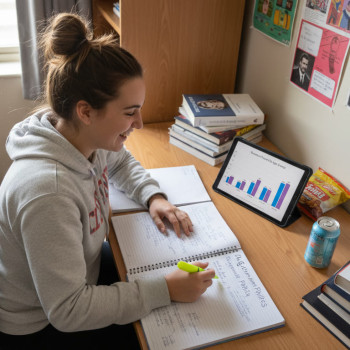Why Teacher Recommendations Still Matter — And Why APs Help
When you picture the college application, your test scores and transcript often steal the spotlight. But there’s a quieter, powerful element that gives admissions committees context and color: the teacher recommendation. A vivid, specific letter can turn a pile of numbers into a memorable student portrait. And if you take AP courses and perform well, you give your recommenders concrete, high-value material to write about.
This post walks you through how AP performance feeds into teacher recs, the things teachers pay attention to, and practical steps you can take right now to make your AP experience recommendation-ready. I’ll share timelines, examples, and even a simple table you can use to track the small wins that matter most. Along the way I’ll mention how Sparkl’s personalized tutoring can help students sharpen skills, increase confidence, and create the kind of in-class growth teachers notice and celebrate.
What Admissions Officers Look For In a Teacher Recommendation
To understand why APs are meaningful, start by knowing what a strong recommendation does for you. Admissions officers typically want to learn:
- How you perform academically in a classroom setting versus on paper.
- Your intellectual curiosity, especially when faced with challenging material.
- Qualities like persistence, collaboration, responsibility, and leadership.
- How you respond to feedback and grow over time.
- Any distinctive contributions you make to classroom culture.
AP courses offer a natural stage for all of these observations. Because AP classes mimic college-level expectations, they’re prime territory for teachers to note growth, resilience, and academic readiness.
How AP Performance Gives Teachers Strong Evidence
1. Concrete academic indicators
AP scores, exam subscores, and performance on AP Classroom assignments are hard evidence a teacher can cite. A recommender who notes that you scored a 4 on the AP exam, improved from a 2 to a 4 over the year, or consistently ranked at the top of AP Classroom progress checks gives an admissions reader something tangible to trust.
2. Demonstrated rigor
Choosing AP courses signals willingness to embrace challenge. A teacher can frame your course load—especially a mix of APs across disciplines—as evidence that you intentionally sought academic rigor and stretched yourself. This is particularly compelling if your schedule included APs outside your comfort zone.
3. Growth narratives
Teachers love a growth story. If you started the year unsure and finished with strong analytical essays, lab work, or problem-solving skills, that arc is gold. Concrete examples — like mastering a statistical method in AP Statistics or improving thesis structure in AP English — make the letter feel specific and believable.
4. Classroom citizenship
Recommendations often highlight how you engage with peers, handle setbacks, and contribute to class discussion. AP classrooms are smaller and often discussion-heavy, so your participation, leadership on group projects, and willingness to ask tough questions become visible.
5. Research and independent work
Many AP courses encourage or require extended projects or independent study. A teacher who supervised your AP Research project or mentored an independent investigation can describe your initiative and capacity for long-term intellectual work — qualities colleges prize.

What Teachers Actually Write About AP Students
Recommendation letters aren’t lists of accomplishments. The most memorable ones tell a story anchored in specific classroom moments. Here are common themes teachers draw from AP classes:
- Evidence of critical thinking: quoting an incisive question you asked or a creative approach you took on an exam prompt.
- Work ethic under pressure: describing how you prepared for the AP exam and how you handled setbacks or feedback.
- Intellectual leadership: examples of you helping classmates, leading a lab team, or facilitating a study group.
- Long-term improvement: showing how you applied feedback across multiple assignments to reach a stronger AP performance.
- Real-world connections: noting when you connected course concepts to community projects, internships, or research.
Specific AP Signals That Make Teachers’ Letters Stronger
Not all AP-related achievements have equal weight in a letter. Here are the most impactful signals teachers can use, and why they matter.
AP Exam Score Trends
A single high score is impressive, but a trajectory matters. If your teacher can say, “Samantha moved from a 2 to a 4 on the AP exam after targeted revisions,” that tells a story of responsiveness and growth.
Consistent AP Classroom / Progress Check Results
Teachers have access to in-course analytics. Frequent top-level performance on progress checks shows sustained mastery and provides quotable details for a letter.
Quality of AP Portfolios or Projects
Extended tasks—like an AP Computer Science project, an AP Studio Art portfolio, or an AP Research paper—create artifacts that teachers can reference. These are tangible demonstrations of skill and dedication.
Active Participation in AP Discussions and Labs
A student who drives discussion or leads lab teams is doing the social and intellectual work teachers value. These moments let a recommender say things like, “He often guided peers to deeper understanding by asking concise, clarifying questions.”
Practical Steps: What You Should Do Now to Help Your Recommender
Great letters rarely happen by accident. Here’s a practical checklist you can follow so your AP performance actually becomes material teachers want to write about.
- Choose the right recommender — usually an AP teacher who knows your academic work well and has observed growth over time.
- Keep a running log of evidence — high-stakes assignments, lab reports, project milestones, and exam practice improvements.
- Request the recommendation with ample time — ideally 4–6 weeks before the deadline.
- Provide a clear, concise brag sheet that includes goals, activities, and the exact instances you want highlighted.
- Share your college list and deadlines so the teacher can tailor tone and emphasis if needed.
What to Include in a Brag Sheet
A well-organized brag sheet makes writing easier for your teacher and improves the letter’s specificity. Include:
- Your most meaningful AP assignments and their outcomes (scores, grades, teacher feedback).
- Examples of class contributions: presentations, discussion leadership, study groups you organized.
- Any mentoring, tutoring, or community projects tied to the AP subject.
- Short personal note on why the subject matters to you and how you plan to study it further in college.
Timing: When To Talk To Your Teachers
Timing is practical and emotional. Here’s a timeline that keeps things comfortable for both you and your teacher:
- Junior year spring or early senior year: Start thinking about who will write your recommendations. If a teacher has been pivotal in an AP course, ask them early.
- 6–8 weeks before your deadline: Officially ask the teacher and hand over your brag sheet and deadlines.
- 2–3 weeks before the deadline: Send a polite reminder and offer any extra materials (updated resume, personal statement draft).
- After submission: Send a thank-you note. A handwritten note is memorable and appreciated.
Sample Timeline Table
| When | What You Do | Why It Helps |
|---|---|---|
| Junior Spring | Identify potential recommenders from AP teachers | Gives teachers time to notice growth and saves last-minute pressure |
| Senior Fall (or early) | Ask and provide brag sheet and deadlines (4–6 weeks ahead) | Ensures thoughtful, not rushed, letters |
| 2–3 Weeks Before | Submit reminder and any updates | Keeps the teacher informed and confident about meeting deadlines |
| After Submission | Send thank-you note | Maintains relationships and shows appreciation |
Examples: How AP Moments Turn Into Letter Lines
Here are a few short, realistic examples of how classroom moments and AP evidence transform into recommendation language.
- From data to praise: “When Maya analyzed the lab data for her AP Biology project, she moved beyond the expected conclusion to propose a novel control experiment. That initiative is the kind of intellectual curiosity she brings to every discussion.”
- From persistence to impact: “After receiving early feedback on his AP Calculus problem sets, Alex systematically addressed conceptual gaps and improved his exam performance from 65% to 92% by the final unit—evidence of disciplined, measurable growth.”
- From leadership to community: “As peer-leader for our AP US History seminar, Jordan organized weekly study groups that increased class averages and created a more collaborative learning environment.”
How to Use AP Data Without Sounding Like a Resume
Numbers are persuasive, but letters should feel human. Encourage your teacher to use data in service of a story rather than letting numbers stand alone. Example: instead of listing your AP score, a teacher might write, “She used targeted feedback from early practice exams to rework her essay structure, which is why she earned a 5 on the exam—proof of her methodical approach to improvement.” That pairs evidence with character.
When AP Scores Don’t Tell the Whole Story
Not every strong student earns perfect AP scores, and that’s okay. Teachers can explain context: testing anxiety, illness on test day, or absorbed class responsibilities that year. If your AP score is lower than your demonstrated in-class performance, your teacher can highlight consistent mastery in coursework, contributions to peers, or a strong project portfolio.
How Tutoring and Targeted Support Strengthen Teacher Recs
Targeted tutoring can accelerate the kinds of observable growth teachers love to describe. When a student engages in deliberate practice—guided by an expert tutor or through a tailored study plan—the improvements visible in class are helpful fodder for a letter.
Sparkl’s personalized tutoring approach—1-on-1 guidance, tailored study plans, expert tutors, and AI-driven insights—fits naturally into that growth narrative. Tutors can help you master weak spots, prepare higher-quality projects, and practice discussion points that make your classroom participation richer. When teachers see consistent improvement, curiosity, and better-quality work, they have a stronger, more specific story to tell.
Real-World Context: Admissions Trends That Favor Depth and Growth
Admissions offices increasingly favor applicants who demonstrate depth in a subject rather than a scattershot approach. A student who takes two to three APs and shows true mastery or growth in those areas often looks stronger than someone who simply racks up AP course titles with uneven performance.
Teachers can amplify a candidate’s depth by describing how the student’s sustained commitment to a subject translated into intellectual maturity. That same telling detail explains why an admissions reader should trust the transcript and consider you ready for college-level work.
Common Mistakes Students Make (And How to Fix Them)
- Waiting too long to ask for recommendations — ask early and equip teachers with materials.
- Providing vague brag sheets — be specific about projects, dates, and examples.
- Assuming a high AP score alone guarantees a glowing letter — cultivate participation and growth, not just test performance.
- Failing to update teachers with new achievements — an updated note helps them revise to include recent accomplishments.
Role Play: What to Say When You Ask
Asking for a recommendation can feel awkward. Here’s a short script you can adapt:
“Hi Mrs. Ramirez — I really enjoyed your AP Chemistry class and I’m applying to college this fall. Would you be willing to write me a recommendation? I’ve put together a one-page summary of my AP assignments, projects, and scores, plus my application deadlines to make it easy. I’d be honored if you could speak to my growth in the lab and my role leading the review sessions.”
This is polite, specific, and helpful. It signals organization and makes the teacher’s job easier — which often results in a better letter.
How to Keep the Momentum After You Ask
Once a teacher agrees, keep them in the loop. Send any supplemental materials, remind them gently as deadlines approach, and always say thank you. Good relationship management helps not only this application but keeps doors open for future advice, letters of recommendation for scholarships, and teacher references down the road.
Putting It All Together: A Short Plan for the Next 6 Months
Whether you’re a junior or senior, here’s a concrete six-month plan to make your AP performance recommendation-ready.
- Month 1: Identify recommenders, create your brag sheet, and begin weekly logs of key assignments.
- Month 2: Use AP Classroom progress checks and targeted practice to strengthen weak areas; consider a tutor for stubborn topics.
- Month 3: Complete a high-quality project or portfolio piece you’d want referenced in a letter.
- Month 4: Request recommendations; hand over your brag sheet and timeline.
- Month 5: Keep teachers updated on any new scores or awards; submit polite reminders two to three weeks before deadlines.
- Month 6: Send thank-you notes and keep a copy of the letter for your records if the teacher offers it; reflect on lessons learned and plan for next year.
Closing Thoughts: Make Your AP Story Easy to Tell
Teacher recommendations are stories of who you are as a learner. AP courses give teachers vivid scenes and reliable data to write those stories convincingly. You can’t control every detail of your AP exam score, but you can control how you show up in class, how you respond to feedback, how thoughtfully you approach projects, and how organized you are when you ask for recommendations.
If you’re looking for targeted help to translate classroom effort into measurable improvement, consider pairing classroom work with personalized support. Sparkl’s 1-on-1 guidance and tailored study plans can help you focus on the specific skills your teacher will notice — stronger essays, cleaner lab reports, and more confident participation. Those are the moments that make recommendations sing.
Final piece of advice: think of your recommenders as collaborators in your success. Keep them informed, give them good material to work with, and show appreciation. With thoughtfulness, preparation, and a few strategic moves, your AP performance will not only demonstrate readiness for college — it will make for recommendation letters that open doors.

Quick Checklist (Printable)
- Identify the best AP teacher recommender(s)
- Keep a 1-page brag sheet and update it weekly
- Collect AP Classroom analytics and progress check screenshots
- Complete at least one standout project or portfolio item
- Request recommendation 4–6 weeks before deadlines
- Send a polite reminder 2–3 weeks before deadline
- Follow up with a thoughtful thank-you note
One Last Thought
Your AP journey is more than a set of numbers. It’s an opportunity to grow, to reveal your curiosity, and to practice the intellectual habits that colleges reward. Make it easy for your teachers to see that growth — and to tell it in a way that truly represents you.
















No Comments
Leave a comment Cancel